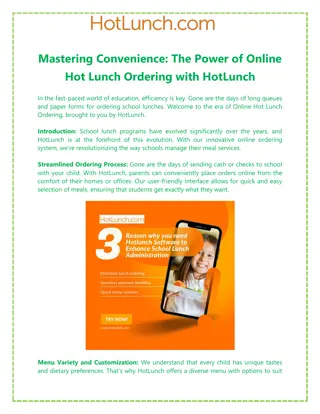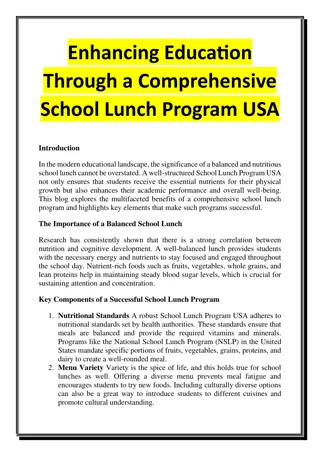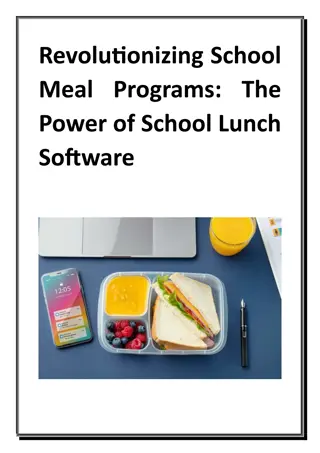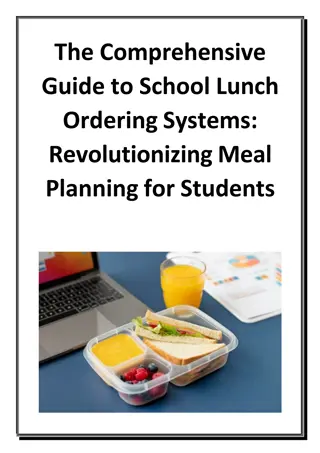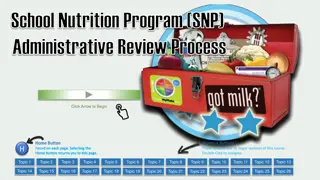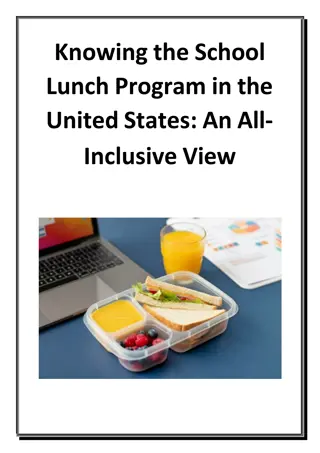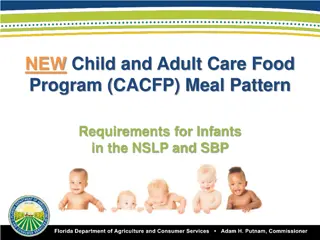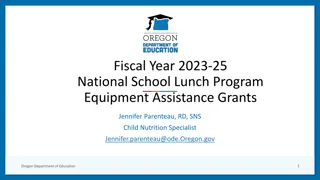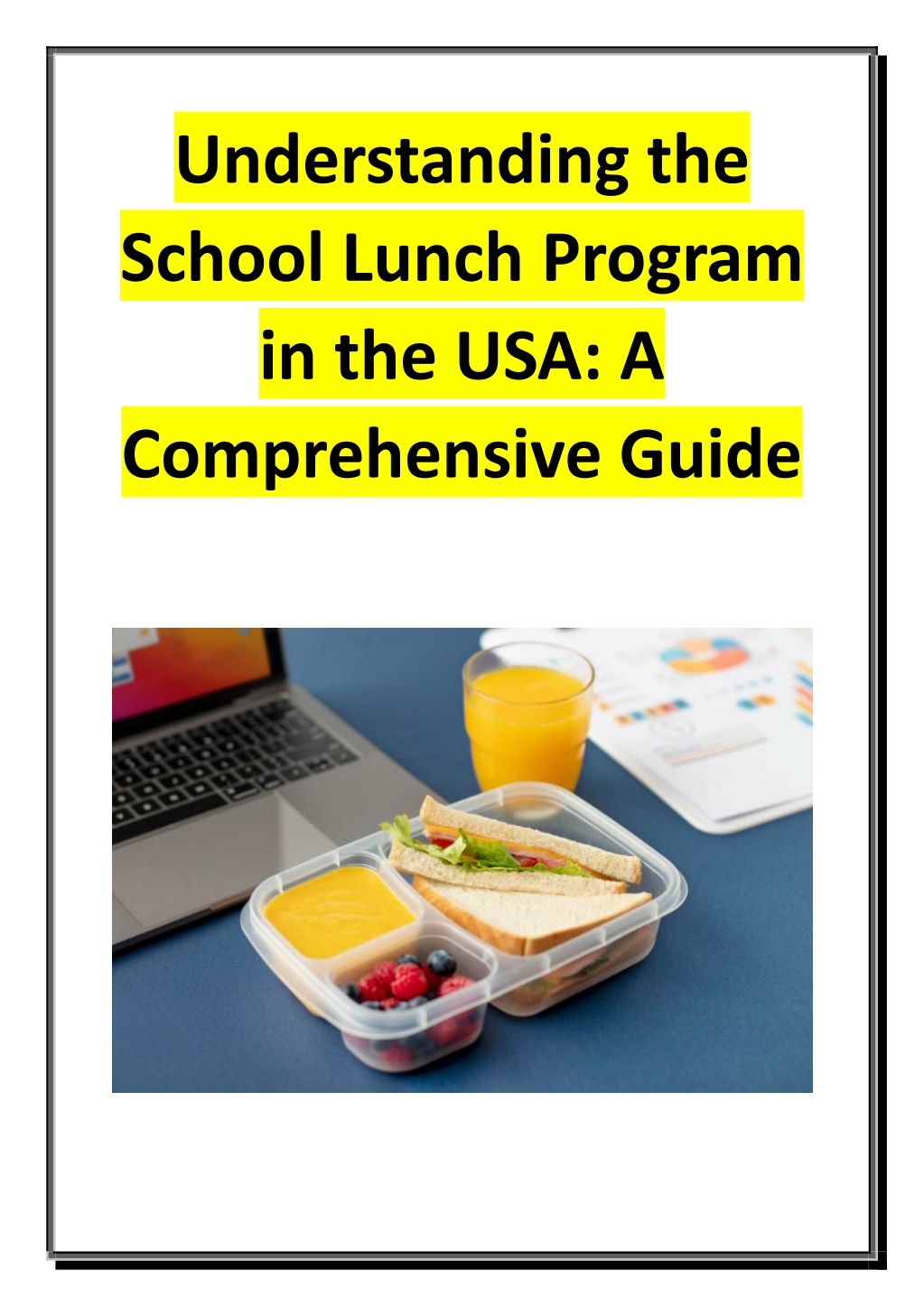
Understanding the School Lunch Program in the USA
The School Lunch Program in the USA is a vital component of the nationu2019s education and public health systems, providing essential nutrition to millions of children every day. While the program has made significant strides in improving the qualit
Uploaded on | 0 Views
Download Presentation

Please find below an Image/Link to download the presentation.
The content on the website is provided AS IS for your information and personal use only. It may not be sold, licensed, or shared on other websites without obtaining consent from the author. Download presentation by click this link. If you encounter any issues during the download, it is possible that the publisher has removed the file from their server.
E N D
Presentation Transcript
Understanding the School Lunch Program in the USA: A Comprehensive Guide
Introduction The School Lunch Program in the USA is an essential component of the nation s education system, providing millions of children with nutritious meals every day. Established to ensure that students receive the necessary nutrition to support their growth, development, and academic success, the program has evolved over the years to address the changing needs of students and the challenges of modern society. This comprehensive guide delves into the history, structure, and impact of the School Lunch Program in the USA, exploring its significance, challenges, and the future of school nutrition. History of the School Lunch Program The origins of the School Lunch Program can be traced back to the early 20th century when concerns about child nutrition and public health began to take center stage. Before the federal program was established, many local communities and charitable organizations provided meals to schoolchildren in need. However, these efforts were often inconsistent and limited in scope. The turning point came during the Great Depression in the 1930s when malnutrition among children became a widespread issue. In response, the federal government began purchasing surplus agricultural products and distributing them to schools, laying the groundwork for a national school lunch program. This initiative aimed to address two key issues: providing nourishment to children and supporting the struggling agricultural sector. In 1946, the National School Lunch Act was signed into law by President Harry S. Truman, officially establishing the National School Lunch Program (NSLP). This landmark legislation created a permanent, federally funded program to provide low-cost or free lunches to students in public and nonprofit private schools. The NSLP was designed to promote the health and well-being of children while also supporting American agriculture. How the School Lunch Program Works The National School Lunch Program operates in more than 100,000 public and nonprofit private schools across the United States. It serves nearly 30 million children every school day, making it one of the largest child nutrition programs in the world. The program is administered by the United States Department of
Agriculture (USDA), which sets nutritional guidelines and provides funding to participating schools. Here s how the program works: 1.Eligibility and Participation: The School Lunch Program is available to all students enrolled in participating schools. Eligibility for free or reduced- price meals is determined by household income. Families with incomes at or below 130% of the federal poverty level are eligible for free meals, while those with incomes between 130% and 185% of the poverty level qualify for reduced-price meals. Schools are reimbursed by the federal government for each meal served, with higher reimbursement rates for free and reduced-price meals. 2.Meal Requirements: The USDA sets specific nutritional guidelines that school lunches must meet to qualify for reimbursement. These guidelines ensure that meals are balanced, providing the necessary calories, protein, fruits, vegetables, grains, and dairy. Over the years, the guidelines have been updated to reflect current dietary recommendations, with an emphasis on whole grains, low-fat dairy, and increased servings of fruits and vegetables. Sodium and trans fats are limited, and schools are encouraged to offer a variety of food options. 3.Reimbursement Rates: The federal government reimburses schools for each meal served under the NSLP. The reimbursement rates vary based on the type of meal (free, reduced-price, or full-price) and the location of the school (with higher rates for schools in high-poverty areas). These funds help schools cover the cost of food, labor, and other expenses associated with operating the lunch program. 4.Additional Programs: In addition to the regular school lunch program, there are several related initiatives aimed at improving child nutrition. The School Breakfast Program (SBP), for example, provides funding for schools to serve breakfast to students, while the Summer Food Service Program (SFSP) ensures that children have access to meals during the summer months when school is not in session. The Fresh Fruit and Vegetable Program (FFVP) offers grants to schools to provide fresh produce to students as a snack during the school day.
Impact of the School Lunch Program The School Lunch Program has a profound impact on the health and well-being of millions of children across the United States. Here are some of the key benefits of the program: 1.Nutritional Support: For many low-income families, school meals provide a critical source of nutrition that they might not otherwise be able to afford. Research has shown that children who participate in the NSLP have better overall diets, with increased consumption of fruits, vegetables, and dairy products. This nutritional support is essential for the physical and cognitive development of children, helping them grow up healthy and ready to learn. 2.Academic Performance: Proper nutrition is closely linked to academic success. Studies have found that children who eat balanced, nutritious meals are more likely to perform better in school. They have improved concentration, memory, and cognitive function, which are all crucial for learning. By providing students with the energy and nutrients they need, the School Lunch Program contributes to better academic outcomes. 3.Reducing Food Insecurity: Food insecurity is a significant issue in the United States, with millions of households struggling to afford enough food. The School Lunch Program plays a vital role in reducing food insecurity among children by ensuring that they have access to at least one nutritious meal each day. This support can alleviate stress for families and help ensure that children do not go hungry. 4.Health Outcomes: The School Lunch Program also plays a role in addressing childhood obesity and other diet-related health issues. By offering healthier meal options and educating students about nutrition, schools can help instill healthy eating habits that last a lifetime. The program s emphasis on fruits, vegetables, and whole grains aligns with national efforts to combat obesity and chronic diseases like diabetes. Challenges and Criticisms Despite its many benefits, the School Lunch Program has faced challenges and criticisms over the years. Some of the key issues include:
1.Nutritional Quality: While the USDA has made efforts to improve the nutritional quality of school meals, some critics argue that the standards do not go far enough. Concerns have been raised about the inclusion of processed foods, high levels of sodium, and the limited availability of fresh produce in some schools. Additionally, there is ongoing debate about the portion sizes and calorie limits, particularly for older students with higher energy needs. 2.Participation Rates: While the program is available to all students, participation rates can vary. Some families may not be aware of their eligibility for free or reduced-price meals, or they may face barriers to applying for the program. Additionally, some students may choose not to participate in the school lunch program due to stigma or preferences for packed lunches. 3.Funding and Resources: Schools often face financial challenges in implementing the School Lunch Program, particularly in meeting the nutritional guidelines while staying within budget. The cost of fresh, healthy ingredients can be higher than that of processed foods, and schools may struggle to cover these costs with the federal reimbursement rates. Additionally, schools in lower-income areas may lack the resources to invest in kitchen equipment, staff training, or other necessary improvements. 4.Waste and Sustainability: Food waste is a significant concern within the School Lunch Program. Some studies have shown that students do not always consume the healthy foods provided, leading to large amounts of food being discarded. This waste represents not only a loss of food but also a waste of resources and funds. Efforts to reduce food waste and promote sustainability within the program are ongoing, but challenges remain. The Future of the School Lunch Program As the School Lunch Program continues to evolve, there are several areas where future improvements may be focused: 1.Enhanced Nutrition Standards: Ongoing research and public health initiatives may lead to further updates to the nutritional guidelines for school meals. These updates could include stricter limits on added sugars,
more emphasis on plant-based options, and greater incorporation of culturally diverse foods. 2.Technology Integration: Advances in technology are likely to play a role in the future of the School Lunch Program. Digital platforms for meal ordering, tracking nutritional information, and managing food inventory could help streamline operations and improve the overall efficiency of the program. 3.Community Engagement: Greater involvement from parents, students, and the broader community could help enhance the School Lunch Program. Initiatives like school gardens, farm-to-school programs, and nutrition education can foster a deeper understanding of healthy eating and create a more positive food culture within schools. 4.Sustainability Efforts: Addressing food waste and promoting sustainable practices will be a key focus moving forward. Schools may explore composting programs, partnerships with local farms, and other initiatives to reduce the environmental impact of their meal programs. Conclusion The School Lunch Program in the USA is a vital component of the nation s education and public health systems, providing essential nutrition to millions of children every day. While the program has made significant strides in improving the quality of school meals and supporting the health and well-being of students, challenges remain. By continuing to refine the program s nutritional standards, addressing funding and resource gaps, and promoting sustainability, the School Lunch Program can further enhance its impact on the lives of children across the country. As we look to the future, it is clear that the School Lunch Program will continue to play a crucial role in ensuring that all students have the nourishment they need to succeed in school and beyond.






